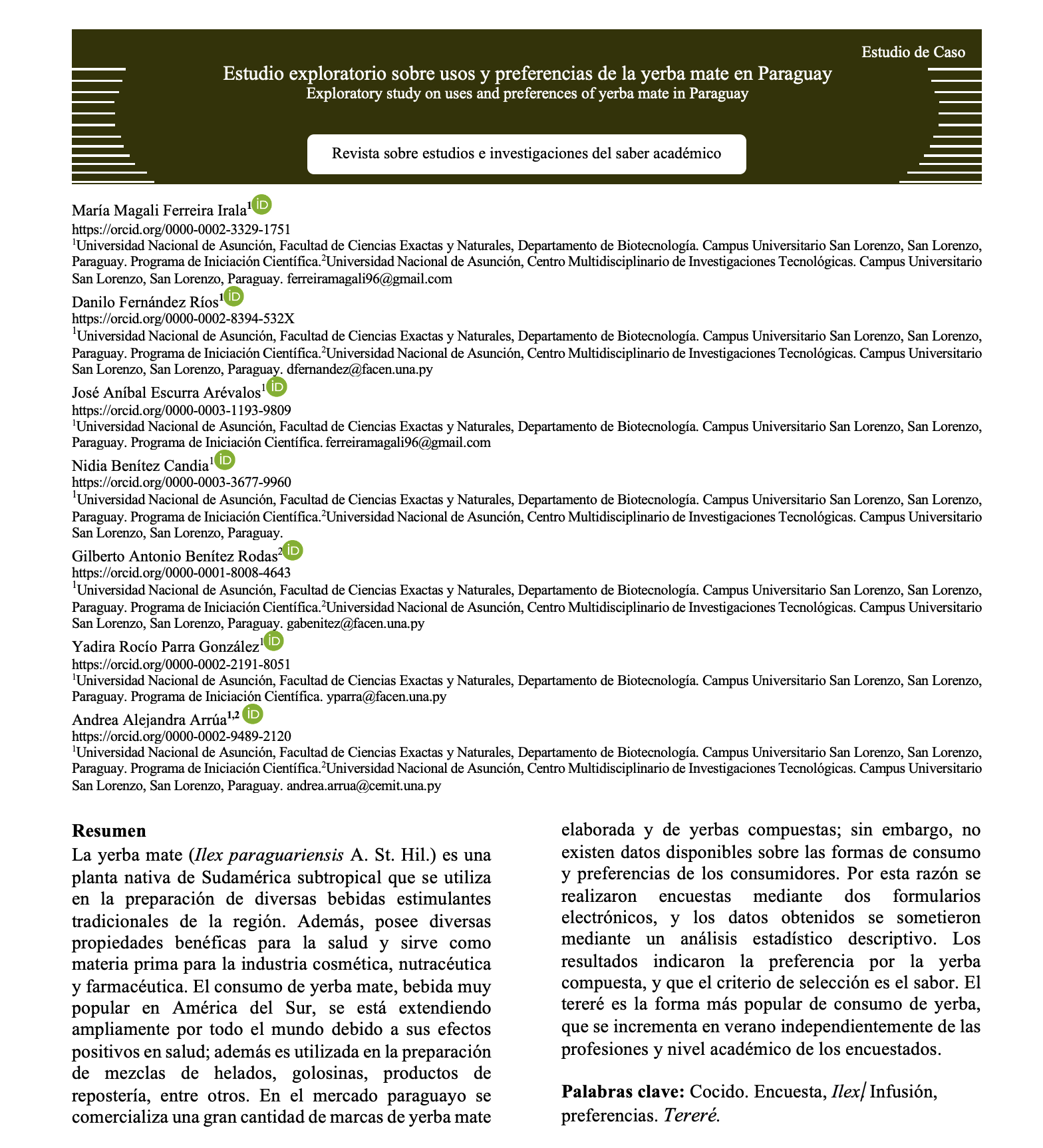Exploratory study on uses and preferences of yerba mate in Paraguay
DOI:
https://doi.org/10.70833/rseisa17item334Keywords:
cocido, survey, ilex, inf, infusion, tereréAbstract
Yerba mate, (Ilex paraguariensis A. St. Hil.) is a plant native to sub-tropical South America which is used for the preparation of various stimulating drinks, and drinks and is part of the traditions of the region. This plant also has several beneficial health properties and serves as raw material for the cosmetic, nutraceutical, and pharmaceutical industries. The consumption of yerba mate, a very popular drink in South America, is spreading widely throughout the world due to its positive effects on health. It is also used in the preparation of ice cream mixes, sweets, confectionery products, among others. In the Paraguayan market, there are many brands of both processed and compound yerba mate; however, there is no public data about forms of consumption and consumer preferences. For these reasons, a survey was made about the consumption habits and preferences in relation to industrialized yerba mate using two electronic forms. With the data obtained, a descriptive statistics analysis was performed through. It was observed that the subjects preferred compound yerba mate and that they make their choice based on taste. Tereré is the most popular form of yerba consumption, which increases in the summer; and this is independent of the subjects’ occupations and academic background.
Downloads
References
ABC Color. (2019). Cifras y mercados de la yerba mate paraguaya - Día Nacional de la Yerba Mate. Noticias Nacionales. https://www.abc.com.py/edicion-impresa/suplementos/comercial/dia-nacional-yerba-mate/2019/10/11/cifras-y-mercados-de-la-yerba-mate-paraguaya/
Agencia de Información Paraguaya. (2019). Paraguay realizará por primera vez un congreso nacional sobre yerba mate. Noticias Nacionales. https://www.ip.gov.py/ip/paraguay-realizara-por-primera-vez-un-congreso-nacional-sobre-yerba-mate/
Blanes, M. L. (2018). Patrimonio Cultural del Mercosur. Presentación. Dossier de Candidatura: Yerba Mate - Ka’a (pp. 1–30). Secretaría Nacional de Cultura. https://backend.educ.ar/refactor_resource/get-attachment/279
Centro Yerbatero Paraguayo. (2022). Centro Yerbatero Paraguayo. Noticias. https://www.facebook.com/Centro-Yerbatero-Paraguayo-1589725391312782
De Bernardi, L. A. (2018). Perfil de la yerba mate. Ministerio de Agricultura, Ganadería y Pesca. https://www.magyp.gob.ar/sitio/areas/ss_mercados_agropecuarios/publicaciones/
Dellacassa, E., Cesio, V., Vázquez, A., Echeverry, S., Soule, S., Menéndez, P., Ferreira, F., & Heinzen, H. (2007). Yerba mate. Historia, uso y propiedades. Revista de La Asociación de Químicos Farmacéuticos Del Uruguay, 51, 16–20. https://www.researchgate.net/profile/Eduardo-Dellacassa/publication/284125789_Yerba_mate_Historia_uso_y_propiedades/links/5777af5908ae1b18a7e438e6/Yerba-mate-Historia-uso-y-propiedades.pdf
Gan, R.-Y., Zhang, D., Wang, M., & Corke, H. (2018). Health Benefits of Bioactive Compounds from the Genus Ilex, a Source of Traditional Caffeinated Beverages. Nutrients, 10(11), 1682. https://doi.org/10.3390/nu10111682
Gortari, J. (2017). «Maldita» Yerba mate: explotación de la mano de obra en las minas yerbateras del Paraguay colonial - Dialnet. TSN. Transatlantic Studies Network: Revista de Estudios Internacionales, 2(3). https://dialnet.unirioja.es/servlet/articulo?codigo=6229209&info=resumen&idioma=ENG%0Ahttps://dialnet.unirioja.es/servlet/articulo?codigo=6229209&info=resumen&idioma=SPA%0Ahttps://dialnet.unirioja.es/servlet/articulo?codigo=6229209
Instituto Nacional de Alimentación y Nutrición. (2022). Listado de productos registrados de yerba mate. Empresas y Productos Registrados. https://www.inan.gov.py/site/?page_id=227
Instituto Nacional de la Yerba Mate. (2020). Informe del Sector Yerbatero diciembra de 2020 (p. 8). INYM.
Instituto Nacional de Tecnología Normalización y Metrología. (2001). Yerba Mate Elaborada Compuesta (NP 35 002 01; Normas Paraguayas). INTN.
Instituto Nacional de Tecnología Normalización y Metrología. (2007). Yerba Mate Elaborada. Requisitos Generales (NP 35 001 93; Normas Paraguayas). INTN.
International Council of Museums. (2021). Yerba Mate - Patrimonio Cultural del Mercosur. Comité Nacional de ICOM Argentina. https://icom-argentina.mini.icom.museum/yerba-mate-patrimonio-cultural-del-mercosur/
Kungel, P. T. A. N., Correa, V. G., Corrêa, R. C. G., Peralta, R. A., Soković, M., Calhelha, R. C., Bracht, A., Ferreira, I. C. F. R., & Peralta, R. M. (2018). Antioxidant and antimicrobial activities of a purified polysaccharide from yerba mate (Ilex paraguariensis). International Journal of Biological Macromolecules, 114(2017), 1161–1167. https://doi.org/10.1016/j.ijbiomac.2018.04.020
La Nación. (2021). El rubro de la yerba mate generó un movimiento económico de US$ 102 millones. Negocios. https://www.lanacion.com.py/negocios/2021/10/26/el-rubro-de-la-yerba-mate-genero-un-movimiento-economico-de-us-102-millones/
Lysiak, E. (2016). Participación de la yerba mate en el consumo argentino de bebidas. In Miscelánea (Issue 74). INTA Ediciones. https://inta.gob.ar/documentos/participacion-de-la-yerba-mate-en-el-consumo-argentino-de-bebidas-0
Organización de las Naciones Unidas (1992). Convención marco de las naciones unidas sobre el cambio climático (Vol. 62301).
Paiva, J. P., Morales, L. P., Mayans, G. U., Villalba, M. A., Arbo, L. M. de, & Bernal, S. S. (2013). Evaluación del Perfil Micológico de la Yerba Mate durante el proceso productivo y producto final en establecimientos yerbateros. Paraguay 2012. In Revista de Salud Pública del Paraguay (Vol. 3, Issue 1, pp. 08–13). http://revistas.ins.gov.py/index.php/rspp/article/view/11
Pereira, C., Cuquel, F., & Matumoto, P. (2020). Yerba mate: Cultivation systems, processing and chemical composition. a review. Scientia Agricola, 78(5), 1–11. https://doi.org/10.1590/1678-992x-2019-0259
Poder Legislativo del Paraguay. (2011). Ley No 4261/Declara Patrimonio Cultural Y Bebida Nacional Del Paraguay Al Terere. In Biblioteca y Archivo del Congreso de la Nación (p. 1). https://www.bacn.gov.py/leyes-paraguayas/2899/declara-patrimonio-cultural-y-bebida-nacional-del-paraguay-al-terere
Portal Uruguay. (2019). No te amargues Los uruguayos consumimos 10 kilos de yerba mate per cápita por año. Negocios y Tendencias. https://www.montevideo.com.uy/Negocios-y-Tendencias/Los-uruguayos-consumimos-10-kilos-de-yerba-mate-per-capita-por-ano-uc728131
Presidencia de la Republica del Paraguay. (1998). Decreto 19.820 Por el cual se crea una Comisión Mixta Multidisciplinaria encargada del Estudio de la Problemática de la Yerba Mate.
Presidencia de la Republica del Paraguay. (2015). Por el cual se modifica parcialmente el artículo 2° del decreto n° 19.820 del 3 de febrero de 1998, "por el cual se crea una comisión mixta multidisciplinaria del estudio de la problemática de la yerba mate.
Samoggia, A., Landuzzi, P., & Vicién, C. E. (2021). Market Expansion of Caffeine-Containing Products: Italian and Argentinian Yerba Mate Consumer Behavior and Health Perception. International Journal of Environmental Research and Public Health, 18(15), 8117. https://doi.org/10.3390/ijerph18158117
Secretaría de Agroindustria. (2019). Cadena de Yerba Mate - Resumen (p. 8). Ministerio de Producción y Trabajo, Presidencia de la Nación Argentina. http://www.alimentosargentinos.gob.ar/HomeAlimentos/Cadenas de Valor de Alimentos y Bebidas/informes/Resumen_Cadena_2019_YERBA_MATE_JUNIO.pdf
Zielinski, A. A. F., Alberti, A., Bona, E., Bortolini, D. G., Benvenutti, L., Bach, F., Demiate, I. M., & Nogueira, A. (2020). A multivariate approach to differentiate yerba mate (Ilex paraguariensis) commercialized in the Southern Brazil on the basis of phenolics, methylxanthines and in vitro antioxidant activity. Food Science and Technology, 40(3), 645–652. https://doi.org/10.1590/fst.15919

Downloads
Published
How to Cite
Issue
Section
Categories
License
Copyright (c) 2023 Maria Magalí Ferreira Irala, Danilo Fernández Ríos, José Aníbal Escurra Arévalos, Nidia Benítez Candia, Gilberto Antonio Benítez Rodas, Yadira Rocío Parra González, Andrea Alejandra Arrúa Widmer

This work is licensed under a Creative Commons Attribution 4.0 International License.
Creative Commons Attribution License CC-BY
You are free to:
Share — copy and redistribute the material in any medium or format.
Adapt — remix, transform, and build upon the material for any purpose, including commercially.
Under the following terms:
Attribution — You must give appropriate credit, provide a link to the license, and indicate if any changes have been made. You may do so in any reasonable way, but not in any way that suggests that you or your use is endorsed by the Licensor.






